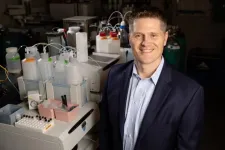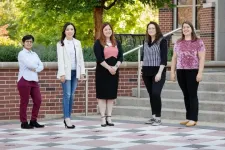INFORMATION:
Study authors also included Yaara Finkel, Avi Gluck, Aharon Nachshon, Dr. Roni Winkler, Tal Fisher, Batsheva Rozman, Dr. Orel Mizrahi and Dr. Michal Schwartz, who are all members of Dr. Noam Stern-Ginossar's group; Dr. Yoav Lubelsky and Binyamin Zuckerman from Prof. Igor Ulitsky's group in the Department of Biological Regulation; Dr. Boris Slobodin from the Department of Biomolecular Sciences - as well as Dr. Yfat Yahalom-Ronen and Dr. Hadas Tamir from the Israel Institute for Biological, Chemical and Environmental Sciences.
Stern-Ginossar's research is supported by Skirball Chair in New Scientists; Knell Family Center for Microbiology; American Committee for the Weizmann Institute of Science 70th Anniversary Lab; Ben B. and Joyce E. Eisenberg Foundation; Maurice and Vivienne Wohl Biology Endowment; and Miel de Botton.
The triple threat of coronavirus
A new study exposes how SARS-CoV-2 tampers with the cell's hardware to outsmart the immune system
2021-05-12
(Press-News.org) Severe symptoms of COVID-19, leading often to death, are thought to result from the patient's own acute immune response rather than from damage inflicted directly by the virus. Immense research efforts are therefore invested in figuring out how the virus manages to mount an effective invasion while throwing the immune system off course. A new study, published today in Nature, reveals a multipronged strategy that the virus employs to ensure its quick and efficient replication, while avoiding detection by the immune system. The joint labor of the research groups of Dr. Noam Stern-Ginossar at the Weizmann Institute of Science and Dr. Nir Paran and Dr. Tomer Israely of the Israel Institute for Biological, Chemical and Environmental Sciences, this study focused on understanding the molecular mechanisms at work during infection by SARS-CoV-2 at the cellular level.
During an infection, our cells are normally able to recognize that they're being invaded and quickly dispatch signaling molecules, which alert the immune system of the attack. With SARS-CoV-2 it was apparent early on that something was not working quite right - not only is the immune response delayed, enabling the virus to quickly replicate, unhindered, but once this response does occur it's often so severe that instead of fighting the virus it causes damage to its human host.
"Most of the research that has addressed this issue so far concentrated on specific viral proteins and characterized their functions. Yet not enough is known today about what is actually going on in the infected cells themselves," says Stern-Ginossar, of the Molecular Genetics Department. "So we infected cells with the virus and proceeded to assess how infection affects important biochemical processes in the cell, such as gene expression and protein synthesis."
When cells are infected by viruses, they start expressing a series of specific anti-viral genes - some act as first-line defenders and meet the virus head on in the cell itself, while others are secreted to the cell's environment, alerting neighboring cells and recruiting the immune system to combat the invader. At this point, both the cell and the virus race to the ribosomes, the cell's protein synthesis factories, which the virus itself lacks. What ensues is a battle between the two over this precious resource.
The new study has elucidated how SARS-CoV-2 gains the upper hand in this battle: It is able to quickly, in a matter of hours, take over the cell's protein-making machinery and at the same time to neutralize the cell's anti-viral signaling, both internal and external, delaying and muddling the immune response.
The researchers showed that the virus is able to hack the cell's hardware, taking over its protein-synthesis machinery, by relying on three separate, yet complementary, tactics. The first tactic the virus uses is to reduce the cell's capacity for translating genes into proteins, meaning that less proteins are synthesized overall. The second tactic is that it actively degrades the cell's messenger RNAs (mRNA) - the molecules that carry instructions for making proteins from the DNA to the ribosomes - while its own mRNA transcripts remain protected. Finally, the study revealed that the virus is also able to prevent the export of mRNAs from the cell's nucleus, where they are synthesized, to the cell's main chamber, where they normally serve as the template for protein synthesis.
"By employing this three-way strategy, which appears to be unique to SARS-CoV-2, the virus is able to efficiently execute what we call 'host shutoff' - where the virus takes over the cell's protein-synthesis capacity," Stern-Ginossar explains. "In this way, messages from important anti-viral genes, which the cell rushes to produce upon infection, do not make it to the factory floor to be translated into active proteins, resulting in the delayed immune response we are seeing in the clinic." The good news is that this study was also successful in identifying the viral proteins involved in the process of host shutoff by SARS-CoV-2, which could spell new opportunities for developing effective COVID-19 treatments.
ELSE PRESS RELEASES FROM THIS DATE:
Only 17 percent of free-flowing rivers are protected, new research shows
2021-05-12
New science about the fate of freshwater ecosystems released today by the journal Sustainability finds that only 17 percent of rivers globally are both free-flowing and within protected areas, leaving many of these highly-threatened systems¬--and the species that rely on them --at risk.
"Populations of freshwater species have already declined by 84 percent on average since 1970, with degradation of rivers a leading cause of this decline. As a critical food source for hundreds of millions of people, we need to reverse this trend," said Ian Harrison, freshwater specialist at Conservation International, adjunct professor ...
Obese girls face heightened risk of cardiovascular disease in adulthood
2021-05-12
By Karina Ninni | Agência FAPESP – A study of 92 adolescents conducted in Brazil suggests girls are more likely than boys to develop metabolic alterations associated with obesity, such as high blood pressure and excessive blood levels of cholesterol and triglycerides (dyslipidemia).
The study was conducted with FAPESP’s support by scientists affiliated with the University of São Paulo’s Biomedical Sciences Institute (ICB-USP) and the Medical School of Santa Casa de Misericórdia de São Paulo (FCM-SCMSP). The findings are reported in an article in the journal Frontiers in Nutrition.
According to the authors, the obese girls displayed a pattern of lipid profile alterations not seen in girls without obesity and a higher propensity to ...
Asian scientists grapple with belonging
2021-05-12
Asian students and faculty have long been a cornerstone of science in the U.S., drawn by the promise of collaboration and cutting-edge research. However, the Asian community is facing increased racist attacks and scrutiny from the government. A cover story in Chemical & Engineering News, the weekly newsmagazine of the American Chemical Society, explores how Asian scientists are reassessing their futures in the U.S.
In the wake of the COVID-19 pandemic, racist attacks against the Asian community in the U.S. have increased notably, with nearly 4,000 incidents reported between March 2020 and February 2021. Some attribute this to former President Donald Trump's rhetoric about the pandemic originating in China, writes Senior Editor Andrea Widener. ...
Mutation profile of acral nevi differs from acral melanoma, Moffitt researchers say
2021-05-12
TAMPA, Fla. -- Melanocytic nevi, or moles, are nonmalignant growths that arise from pigment producing cells of the skin. They are mostly found in sun-exposed areas; however, they also can be found in sun-protected areas, such as the palms, soles of feet and nail beds, where they are known as acral nevi. While the mutation profile of nevi in sun-exposed areas is well understood, less is known about the genes that are commonly mutated in acral nevi. And while a subset of melanoma of sun-exposed skin arises in nevi, the link between nevi and melanoma in acral skin is poorly understood. In ...
Major differences in COVID patient care caused by insufficient data, misleading advice
2021-05-12
NEW YORK, NY--While there was extensive use of drug repurposing throughout the first 10 months of the COVID-19 pandemic, there was substantial heterogeneity over the types of drugs used for treatment purposes globally. Some drugs, including hydroxychloroquine, saw sharp declines in use, while adjunctive therapies grew into a more relied upon method for patient management.
In a number of cases, scientific discovery overturned misconceptions proclaimed via press conferences and social media.
The OHDSI network study "Use of repurposed and adjuvant drugs in hospital patients with covid-19: multinational network cohort study," published May 11 by The BMJ, provides a global view ...
Kefir packs less of a probiotic punch than labels claim
2021-05-12
URBANA, Ill. - Gut health is having a moment, with sales of fermented foods such as kefir, kombucha, and kimchi steadily on the rise. The benefits of "good bacteria" in fermented foods and supplements go well beyond the gut, moderating immune responses, heart health, weight, and even mood. But do products hold up to the claims on their labels?
A new study from the University of Illinois and The Ohio State University examined bacterial content of five brands of kefir, a fermented dairy beverage often likened to drinkable yogurt. The research showed the majority of products overstated bacterial density and contained species not included on the label.
"Our ...
Research reveals new approach to understanding our wellbeing
2021-05-12
The ability to connect and feel a sense of belonging are basic human needs but new Swansea University research has examined how these are determined by more than just our personal relationships.
Research led by psychologist Professor Andrew Kemp, of the College of Human and Health Sciences, highlights the importance of taking a wider approach to wellbeing and how it can be influenced by issues such as inequality and anthropogenic climate change.
Professor Kemp worked with PhD student Jess Mead and consultant clinical psychologist Dr Zoe Fisher, of the University's Health and Wellbeing Academy, on the study which presents a transdisciplinary ...
Youths with diverse gender identities bullied up to three times more than peers
2021-05-12
CHAMPAIGN, Ill. -- Young people with diverse gender identities may be bullied and victimized up to three times more often than peers who identify as male or female, a new study of more than 4,464 adolescents in Illinois found.
The students were part of a statewide survey of eighth- through 12th-grade youths in Illinois schools.
"Transgender youths reported the highest rates of all forms of peer victimization, which were double to nearly triple those of males and up to 2.6 times higher than those of females," said social work professor Rachel Garthe of the University of Illinois Urbana-Champaign, who led the research.
"Slightly ...
Brain research gets a boost from mosquitos
2021-05-12
Can a protein found in a mosquito lead to a better understanding of the workings of our own brains? Prof. Ofer Yizhar and his team in the Weizmann Institute of Science's Neurobiology Department took a light-sensitive protein derived from mosquitos and used it to devise an improved method for investigating the messages that are passed from neuron to neuron in the brains of mice. This method, reported today in Neuron, could potentially help scientists solve age-old cerebral mysteries that could pave the way for new and improved therapies to treat neurological and psychiatric conditions.
Yizhar and his lab team develop so-called optogenetic methods - research techniques that allow them to "reverse engineer" the activity of specific brain circuits ...
Fighting food insecurity by building better beans
2021-05-12
EAST LANSING, Mich. - As climate change threatens global food security, researchers at Michigan State University are building better beans crucial to human nutrition by tapping into the genetics of the more heat-resistant tepary bean.
The tepary bean (Phaseolus acutifolius A. Gray) is a sister of the common bean which includes kidney, pinto and navy beans. "The common bean is the number one source of protein and nutrients for many people living in Central America and Africa," said Robin Buell, a professor of plant biology in MSU's College of Natural Science and former director of the Plant Resilience Institute.
Her research on bean genetics was published May 11 in Nature Communications.
"Mother nature has already made plants that are adapted to different climates," ...
LAST 30 PRESS RELEASES:
Fat tissue around the heart may contribute to greater heart injury after a heart attack
Jeonbuk National University researcher proposes a proposing a two-stage decision-making framework of lithium governance in Latin America
Chromatin accessibility maps reveal how stem cells drive myelodysplastic progression
Cartilaginous cells regulate growth and blood vessel formation in bones
Plant hormone allows lifelong control of proteins in living animal for first time
Swedish freshwater bacteria give new insights into bacterial evolution
Global measures consistently underestimate food insecurity; one in five who suffer from hunger may go uncounted
Hidden patterns of isolation and segregation found in all American cities
FDA drug trials exclude a widening slice of Americans
Sea reptile’s tooth shows that mosasaurs could live in freshwater
Pure bred: New stem cell medium only has canine components
Largest study of its kind highlights benefits – and risks – of plant-based diets in children
Synergistic effects of single-crystal HfB2 nanorods: Simultaneous enhancement of mechanical properties and ablation resistance
Mysterious X-ray variability of the strongly magnetized neutron star NGC 7793 P13
The key to increasing patients’ advance care medical planning may be automatic patient outreach
Palaeontology: Ancient tooth suggests ocean predator could hunt in rivers
Polar bears may be adapting to survive warmer climates, says study
Canadian wildfire smoke worsened pediatric asthma in US Northeast: UVM study
New UBCO research challenges traditional teen suicide prevention models
Diversity language in US medical research agency grants declined 25% since 2024
Concern over growing use of AI chatbots to stave off loneliness
Biomedical authors often call a reference “recent” — even when it is decades old, analysis shows
The Lancet: New single dose oral treatment for gonorrhoea effectively combats drug-resistant infections, trial finds
Proton therapy shows survival benefit in Phase III trial for patients with head and neck cancers
Blood test reveals prognosis after cardiac arrest
UBCO study finds microdosing can temporarily improve mood, creativity
An ECOG-ACRIN imaging study solves a long-standing gap in metastatic breast cancer research and care: accurately measuring treatment response in patients with bone metastases
Cleveland Clinic presents final results of phase 1 clinical trial of preventive breast cancer vaccine study
Nationally renowned anesthesiology physician-scientist and clinical operations leader David Mintz, MD, PhD, named Chair of the Department of Anesthesiology at the UM School of Medicine
Clean water access improves child health in Mozambique, study shows
[Press-News.org] The triple threat of coronavirusA new study exposes how SARS-CoV-2 tampers with the cell's hardware to outsmart the immune system


